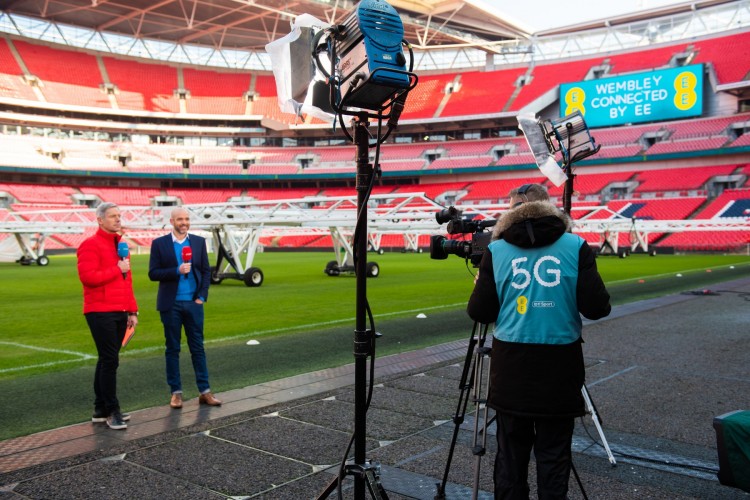Report: 5G to drive video enhancements
May 3, 2022

By 2027, 5G subscriptions are forecast to reach 4.4 billion globally, unleashing a massive consumer base demanding increasingly immersive experiences and wireless engagement made better by 5G. A recent report commissioned by mobile and video technology research and development company InterDigital, and written by market research firm Futuresource Consulting, examines the video innovations, emerging use cases, and immersive experiences made possible by the rollout of 5G networks and adoption of 5G services worldwide, and explores how video innovations and services might harness the advances in 5G networking technology.
Over the next five years, 5G is expected to deliver on its promises of gigabit speeds, ultra-low latency, higher reliability, and improved density in device connectivity, and will dramatically transform the landscape for existing and new applications through the use of 5G for video contribution, television transmission, live events, local broadcast, VR opportunities, and more.
Specifically, the report, Video over 5G: New Networks, New Possibilities, found::
5G will be a game changer for broadcasting live video because of its characteristics of increased reliability with very low latency capable of delivering and maintaining superb video quality. 5G is expected to bring greater simplicity and flexibility to camera signal delivery, which has historically involved complex combinations of wired and wireless technologies. As a result, video delivered over 5G holds the promise of reduced production costs.
5G will create significant opportunity for television delivery and viewership by enabling broadcasters and content providers to expand their reach across a wide range of end devices, while consumers are afforded access to even richer content on their smartphones, tablets, TVs, and other devices. Today’s mobile networking standards offer the potential to deliver with much greater efficiencies than incumbent TV broadcast technologies. In fact, LTE broadcast capability is an integral part of the 5G standard, which offers an alternative to traditional satellite, cable, and terrestrial television distribution – optimising bandwidth usage and minimising distribution costs.
Live events will be dramatically transformed by 5G, especially following the COVID-19 pandemic, which forced a swift adoption of remote production techniques and accelerated the transition to IP networks. Broadcasters increasingly depend on wireless networks for everything from uploading news stories from the field to using LTE-enabled video cameras during live sporting events, and 5G will no doubt extend the bandwidth and boost reliability of these transmissions.
5G’s support for low latency, ultra-reliable, high-density data is a must when it comes to proliferating VR experiences and the metaverse, as increased levels of immersive sensory stimuli are prone to cause nausea and discomfort if the user’s senses fall out of sync with what their body and brain expects them to be seeing. In addition, linking future VR devices to cloud-based GPUs via a 5G connection could help reduce hardware costs and improve device capability for consumers, with the potential to encourage greater market adoption.
New codecs such as Versatile Video Coding (VVC) and Deep Neural Network Video Coding (DNNVC) have emerged to support more efficient transmissions of ultra-high definition (UHD) content and new services beyond video entertainment made possible by 5G networks. The compression benefits delivered by industry’s array of new and existing codecs enables richer video content to be delivered at lower costs to video providers and with lower latency to meet broadcaster needs.
With an installed base expected to exceed 3 billion 5G-enabled smartphones by 2027, mobile devices will drive majority of initial 5G adoption and new video experiences. As the world’s most ubiquitous device with 4.2 billion units installed globally in 2021 and a personal penetration rate of 53 per cent, the smartphone is quickly becoming a ‘go-to’ device for media consumption for a variety of distribution platforms, from subscription video on demand (SVoD) services such as Netflix, to user generated content (UGC) on social media platforms such as TikTok or video sharing sites such as YouTube. 5G simply makes the experience better.
5G will not only unlock entirely new opportunities for video technology, but also catalyse the improvement and innovation of existing applications.
“Significant engineering and innovation has shaped the emergence of 5G and we are beginning to realise the benefits of this enhanced wireless ecosystem, particularly for video and video-enabled experiences,” noted Henry Tirri, Chief Technology Officer, InterDigital. “This report in partnership with Futuresource Consulting highlights myriad applications for 5G in the video realm where consumers are demanding increasingly ubiquitous and immersive experience. For fifty years, InterDigital has developed foundational wireless and video technologies and contributed to the critical standards that bring us each a step closer to immersive, realistic experiences in new realms like the metaverse and beyond.”
“Unquestionably, all existing video applications will be ‘better on 5G’,” added Simon Forrest, Principal Technology Analyst at Futuresource. “The challenge now is for industry to develop new audio-visual experiences that can happen ‘only on 5G’.”
The report outlines the ways higher bandwidth, lower latency, and new features such as network slicing, enable industry and enterprise to imagine and develop those new video applications.
